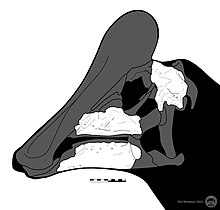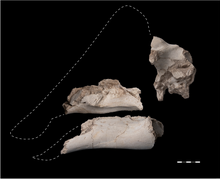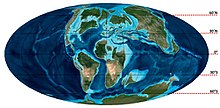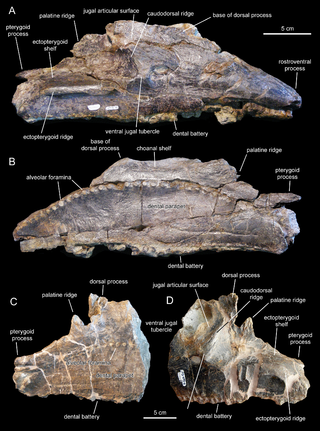
Pararhabdodon is a genus of tsintaosaurin hadrosaurid dinosaur, from the Maastrichtian-age Upper Cretaceous Tremp Group of Spain. The first remains were discovered from the Sant Romà d’Abella fossil locality and assigned to the genus Rhabdodon, and later named as the distinct species Pararhabdodon isonensis in 1993. Known material includes assorted postcranial remains, mostly vertebrae, as well as maxillae from the skull. Specimens from other sites, including remains from France, a maxilla previously considered the distinct taxon Koutalisaurus kohlerorum, an additional maxilla from another locality, the material assigned to the genera Blasisaurus and Arenysaurus, and the extensive Basturs Poble bonebed have been considered at different times to belong to the species, but all of these assignments have more recently been questioned. It was one of the last non-avian dinosaurs known from the fossil record that went extinct during the Cretaceous-Paleogene extinction event.

Koutalisaurus is a potentially dubious genus of extinct hadrosaurid dinosaur from the Arenysaurini. It is based on a mostly complete dentary from the Maastrichtian-age Upper Cretaceous Tremp Formation near the town of Abella de la Conca, Lleida, Spain.

Phosphatodraco is a genus of azhdarchid pterosaur that lived during the Late Cretaceous of what is now Morocco. In 2000, a pterosaur specimen consisting of five cervical (neck) vertebrae was discovered in the Ouled Abdoun Phosphatic Basin. The specimen was made the holotype of the new genus and species Phosphatodraco mauritanicus in 2003; the genus name means "dragon from the phosphates", and the specific name refers to the region of Mauretania. Phosphatodraco was the first Late Cretaceous pterosaur known from North Africa, and the second pterosaur genus described from Morocco. It is one of the only known azhdarchids preserving a relatively complete neck, and was one of the last known pterosaurs. Additional cervical vertebrae have since been assigned to the genus, and it has been suggested that fossils of the pterosaur Tethydraco represent wing elements of Phosphatodraco.

Zarafasaura is an extinct genus of elasmosaurid known from the Ouled Abdoun Basin of Morocco. As a relatively small elasmosaur, it would have measured around 3–4 metres (9.8–13.1 ft) long and weighed about 100 kilograms (220 lb).

Blasisaurus is a genus of lambeosaurine hadrosaurid dinosaur from the Late Cretaceous. It is known from a partial skull and skeleton found in late Maastrichtian-age rocks of Spain. The type species is Blasisaurus canudoi, described in 2010 by Penélope Cruzado-Caballero, Xabier Pereda-Suberbiola and José Ignacio Ruiz-Omeñaca, a group of researchers from Spain.
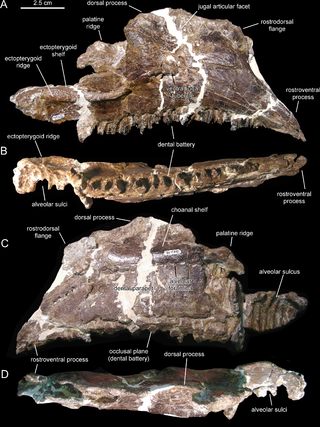
Canardia is an extinct genus of lambeosaurine dinosaur known from the Late Cretaceous Marnes d'Auzas Formation of Haute-Garonne department, in Occitanie region, southwestern France. The type species Canardia garonnensis was first described and named by Albert Prieto-Márquez, Fabio M. Dalla Vecchia, Rodrigo Gaete and Àngel Galobart in 2013. It is only known from juvenile specimens. The name of the genus comes from “canard”, the French word for “duck”, an allusion to the fact that this animal belongs to the hadrosaurids which are also known as duck-billed dinosaurs. The specific epithet garonnensis refers to the Haute-Garonne department where this dinosaur has been found. Although universally recognized as a lambeosaurine, its precise position within them is debated. Some authors consider it as a close relative of the genus Aralosaurus from Central Asia with which it would form the tribe Aralosaurini, while others include it in a more derived clade, the Arenysaurini in which all lambeosaurines from Europe and North Africa are placed. Canardia was one of the last non-avian dinosaurs and lived between 67,5 and 66 my on the former Ibero-Armorican Island, which included much of France and Spain.

Aralosaurini is a proposed tribe of hadrosaurid dinosaurs belonging to the subfamily Lambeosaurinae. The members of this group lived in Asia and Europe during the end of the Late Cretaceous about 83.6 to 66.0 million years ago. The clade may not be monophyletic, with Canardia and Aralosaurus potentially instead being unrelated primitive members of the subfamily.
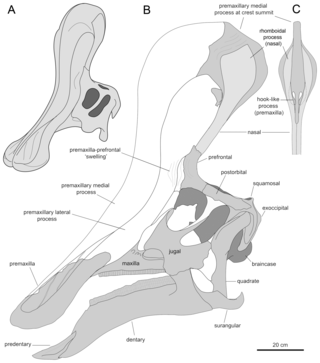
Tsintaosaurini is a tribe of basal lambeosaurine hadrosaurs native to Eurasia. It is thought to contains the genera Tsintaosaurus, Pararhabdodon and Koutalisaurus, though some studies have questioned its existence as a natural grouping.

The Oulad Abdoun Basin is a phosphate sedimentary basin located in Morocco, near the city of Khouribga. It is the largest in Morocco, comprising 44% of Morocco's phosphate reserves, and at least 26.8 billion tons of phosphate. It is also known as an important site for vertebrate fossils, with deposits ranging from the Late Cretaceous (Cenomanian-Turonian) to the Eocene epoch (Ypresian), a period of about 25 million years.

Adelolophus is a genus of lambeosaurine dinosaur from Upper Cretaceous rocks in the U.S. state of Utah. The type and only known species is A. hutchisoni; the type specimen consists only of a broken maxilla. It constitutes the oldest known lambeosaur remains from North America, as well as the only known lambeosaur species from the Wahweap Formation, of which it pertains to the Upper Member. Among its relatives, it seems to be particularly similar to Parasaurolophus, rather than animals like Lambeosaurus; phylogenetic analysis confirms this, finding it in Parasaurolophini. It would have lived in a wet environment, bordering on the sea but with a more arid season during some times of the year. This environment would have been shared with a diverse variety of fish and turtles, as well as other dinosaurs like ceratopsids and tyrannosaurids.

Chenanisaurus is a genus of predatory abelisaurid dinosaur, with a single known species C. barbaricus. It comes from the upper Maastrichtian phosphates of the Ouled Abdoun Basin in Morocco, North Africa. The animal is known from a holotype, consisting of a partial jaw bone, and several isolated teeth found in the same beds. Chenanisaurus is one of the largest members of the Abelisauridae, and one of the last, being a contemporary of the North American Tyrannosaurus. It would have been among the dinosaur species wiped out by the Chicxulub asteroid impact and the Cretaceous-Paleogene mass extinction that followed.

Tethydraco is a genus of pterodactyloid pterosaur that lived during the Late Cretaceous period of what is now the area of present Morocco, about 66 million years ago. Tethydraco was originally assigned to the family Pteranodontidae. Some researchers argued that subsequently described material suggests that it may have been an azhdarchid, and possibly synonymous with Phosphatodraco, though this has been disputed. The type and only species is T. regalis.

Adynomosaurus is a genus of lambeosaurine dinosaur from the Late Cretaceous of what is now Catalonia, Spain. First discovered in 2012, it was named in 2019 with the type and only species being Adynomosaurus arcanus. It is only known from scant material, but is distinguished from other hadrosaurs by its weakly developed shoulder blade which would have had underdeveloped musculature, which lends it its scientific name, partially from the Greek word for "weak". Its exact relationships with other hadrosaurs remain unresolved, with it not consistently being recovered as a relative of any other specific genera, though some studies have allied it with Tsintaosaurini or even found it outside of Hadrosauridae. It would have lived as part of a diverse coastal estuary ecosystem, made up of meandering rivers and mud flats. The discovery of Adynomosaurus adds to the very incomplete fossil record of hadrosaurid dinosaurs in the Late Cretaceous of Europe, and it fits into a picture of major ecological turnover that was occurring during the Maastrichtian stage in the region.
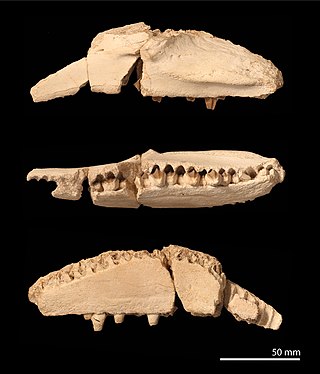
Ajnabia is a genus of lambeosaurine hadrosaur from the Late Cretaceous (Maastrichtian) of Morocco. It is the first definitive hadrosaur from Africa, and is thought to be related to European dinosaurs like Arenysaurus. The discovery of Ajnabia came as a surprise to the paleontologists who found it, because Africa was isolated by water from the rest of the world during the Cretaceous, such that hadrosaurs were assumed to have been unable to reach the continent. Ajnabia is relatively small and similar in size to its contemporary relative Minqaria, which is estimated to have reached 3.5 metres (11 ft) in total body length. Assuming that the holotype represents an adult, Ajnabia would be one of the smallest if not the smallest known hadrosaurids.

Arenysaurini is a proposed tribe of primitive lambeosaurine hadrosaurs. It is composed of genera found in Europe and North Africa during the end of the Cretaceous period, and has been suggested to unite all lambeosaurs from the former continent into a singular monophyletic group.

Gavialimimus is an extinct genus of plioplatecarpine mosasaur from the Maastrichtian of Morocco. The holotype MHNM.KHG.1231, an articulated skull and associated fragmentary postcrania, was found in the Ouled Abdoun Basin.
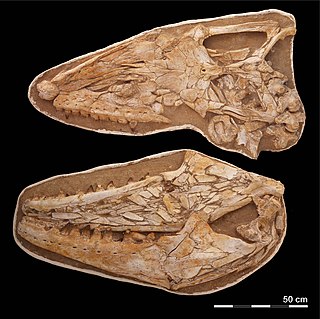
Thalassotitan is an extinct genus of large mosasaurs that lived during the late Maastrichtian of the Cretaceous period in what is now Morocco, around 66 million years ago. The only known species is T. atrox, described in 2022 from fossils discovered in the Ouled Abdoun Basin, where many other mosasaurs have been found. It was assigned to the tribe Prognathodontini alongside other mosasaurs like Prognathodon and Gnathomortis. The prognathodontines are separated from other mosasaurs based on their massive jaws and robust teeth.
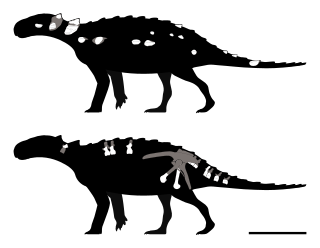
Patagopelta is an extinct genus of ankylosaurian dinosaur from the Late Cretaceous Allen Formation of Argentina. The genus contains a single species, P. cristata, known from a partial skeleton. While originally described as a nodosaurine, later discoveries provided support for parankylosaurian affinities for the taxon. Patagopelta is a very small ankylosaur, comparable in size to the dwarf nodosaurid Struthiosaurus, about 2 m (6.6 ft) long.
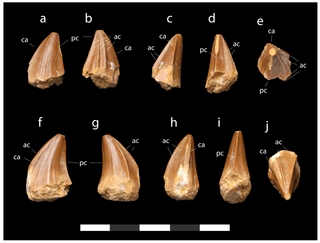
Stelladens is an extinct genus of mosasaurine. Fossils of Stelladens have been recovered from the Late Cretaceous Ouled Abdoun Basin of Morocco. The genus contains a single species, S. mysteriosus. It was a medium-sized mosasaur, measuring about 5 metres (16 ft) long.
